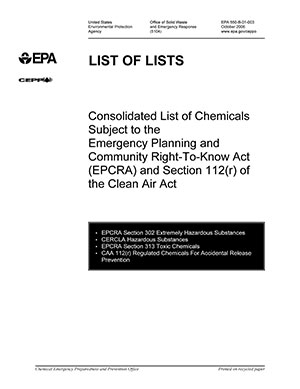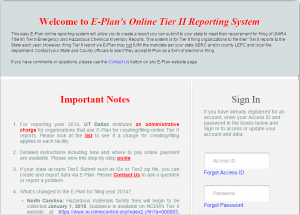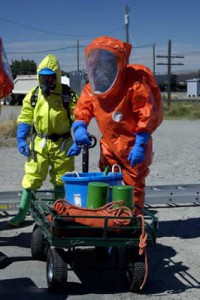Background
In December 1984, a cloud of highly toxic methyl isocyanite was released from a chemical plant in Bhopal India. 2000 people were killed and thousands more injured. Eight months later, a less toxic derivative of the same chemical was released from a plant in West Virginia. In Bhopal, prevention equipment had been installed and a local evacuation plan developed. At the time of the release, the equipment was not in service and the surrounding communities were unaware of the evacuation plans. These two incidents caused the United States government to enact legislation to ensure that equipment and response plans are in place, and that information is available to the public on the hazardous materials in their communities.
Submission
Submission of Tier One or Tier Two forms is required by Title III of the Superfund Amendments and Reauthorization Act of 1986, Section 312, Public Law 99-499, codified at 42 U.S.C. Section 11022. The Local Emergency Planning Committee determines whether a facility will be asked to submit a Tier One or Tier Two form.
Reports must be submitted annually by March 1st of each year. Copies of the report must be submitted to the State Emergency Response Commission (SERC), Local Emergency Planning Committee (LEPC) or Tribal Emergency Planning Committee (TERC) and the fire department with jurisdiction over the facility.
Purpose
The purpose of this Tier reports is to provide State and local officials and the public with specific information on hazardous chemicals present in the community during the previous year.
Under Sections 301-303 of EPCRA, LEPCs (known as AHAD in Gallatin County) must organize collected chemical information and develop emergency response plans for their community. Facilities where extremely hazardous substances are present above specified threshold planning quantities must participate in the planning process. Section 304 requires facilities to report accidental releases of certain hazardous substances above specified reportable quantities to the SERC and AHAD (a.k.a. LEPC). Sections 311-312 require submission of the Tier reports and Section 313 requires manufacturing facilities that release certain toxic chemicals to report the total amount of emissions to the EPA and to state officials.
This legislation creates a working partnership, consisting of industry, small business, state and local government, public health and emergency response agencies and interested citizens. These entities use the information provided in the Tier reports to develop emergency response plans. The AHAD (a.k.a. LEPC), through Gallatin County Emergency Management, maintains copies of the Tier reports. Upon request from a member of the public, information must be provided regarding the chemicals housed at specific facilities. The information enables emergency response personnel to respond safely to chemical accidents.
Who Must Report
 Any business with one or more hazardous chemicals may have to report under Community Right to Know. If a facility has hazardous chemicals on site, but does not meet the Threshold Planning Quantity for the specific chemical there may not be a reporting requirement. However, if a citizen requests information on a facility that does not have an annual reporting requirement, that facility is still required to submit a report under Community Right to Know.
Any business with one or more hazardous chemicals may have to report under Community Right to Know. If a facility has hazardous chemicals on site, but does not meet the Threshold Planning Quantity for the specific chemical there may not be a reporting requirement. However, if a citizen requests information on a facility that does not have an annual reporting requirement, that facility is still required to submit a report under Community Right to Know.
There are four criteria which will assist in determining whether a facility has a reporting requirement:
- Type of facility
- Presence of hazardous chemicals
- Amount of chemicals present
- Any applicable exemptions
For more information on determining whether your facility is required to report, see the publication “Community Right-to-Know and Small Business, Understanding Sections 311 and 312 of the Emergency Planning and Community Right-to-Know Act of 1986.”
What Chemicals are Included
Any hazardous chemical present at a facility in quantities equal to or greater than established threshold amounts, unless the chemicals are excluded under Section 311(e) of Title III. Hazardous chemicals are any substance for which your facility must maintain an MSDS under OSHA’s Hazard Communication Standard.
 Section 311(e) of Title III excludes the following substances:
Section 311(e) of Title III excludes the following substances:
- Any food, food additive, color additive, drug, or cosmetic regulated by the Food and Drug Administration;
- Any substance present as a solid in any manufactured item to the extent exposure to the substance does not occur under normal conditions of use;
- Any substance to the extent it is used for personal, family, or household purposes, or is present in the same form and concentration as a product packaged for distribution and use by the general public;
- Any substance to the extent it is used in a research laboratory or a hospital or other medical facility under the direct supervision of a technically qualified individual;
- Any substance to the extent it is used in routine agricultural operations or is a fertilizer held for sale by a retailer to the ultimate customer.
Reporting Thresholds
Minimum thresholds have been established for Tier One/ Tier Two reporting under Title III, Section 312. These thresholds are as follows:
For Extremely Hazardous Substances (EHSs) designated under Section 302 of Title III, the reporting threshold is 500 pounds (or 227 kg.) or the threshold planning quantity (TPQ), whichever is lower.
For all other hazardous chemicals for which facilities are required to have or prepare an MSDS, the minimum reporting threshold is 10,000 pounds (or 4.540 kg.).
Reports need to be submitted for all hazardous chemicals that were present at a facility at any time during the previous calendar year at levels that equal or exceed these thresholds.
A requesting official may limit the responses required under Tier Two by specifying particular chemicals or groups of chemicals. Such requests apply to hazardous chemicals regardless of established thresholds.
List of Lists
This is a consolidated list of chemicals subject to reporting requirements under EPCRA (SARA Title III) and Section 112(r ) of the Clean Air Act. The list was prepared to assist facilities handling chemicals determine whether or not they need to report, and for a specific chemical, what reports need to be submitted. It also helps facilities identify whether they are subject to accident prevention regulations under CAA 112(r). Chemicals on the list are ordered both by the Chemical Abstracts Service (CAS) registry number and alphabetically. The list provides he Threshold Planning Quantity (TPQ) and Reportable Quantity (RQ) for EPCRA Section 302 Extremely Hazardous Substances (EHSs),the RQs for CERCLA (Comprehensive Environmental Response, Compensation, and Liability Act)hazardous substances which are substances that are considered severely harmful to human health and the environment, The TPQ for CAA substances for accidental release prevention, EPCRA Section 212 Toxic Chemicals and RCRA (Resource Conservation and Recovery Act) substances and their codes.
 Changes-epcra-cercla-caa-112r-consolidated-list-lists-march-2015
Changes-epcra-cercla-caa-112r-consolidated-list-lists-march-2015
Submitting Tier Data in Gallatin County
 Submissions to the Gallatin County LEPC (a.k.a. AHAD) in compliance with SARA Title III is accepted only in the following method:
Submissions to the Gallatin County LEPC (a.k.a. AHAD) in compliance with SARA Title III is accepted only in the following method:
- Utilizing E-Plan at www.erplan.net.
** Gallatin County does not accept paper or emailed submissions.
Information on submitting to the Montana State Emergency Response Commission is available at: http://deq.mt.gov/Tier2.mcpx.
For information on submitting to your local fire department, please contact your fire protection agency directly.


